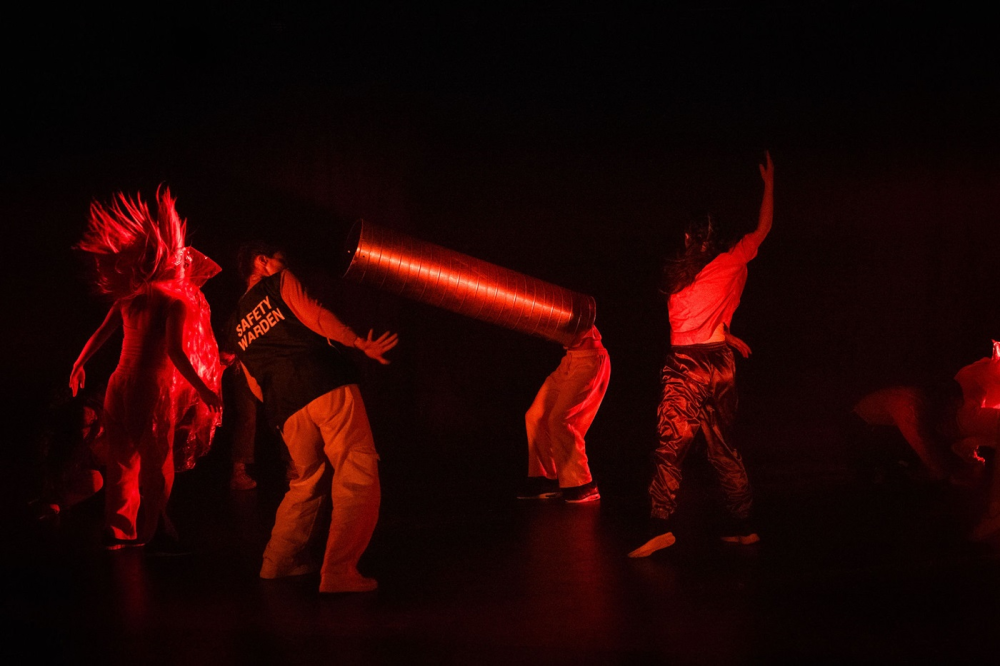Te Pou Theatre, Auckland
16-19 November 2023
Reviewed by Jenny Stevenson

In a break with tradition Unitec Discipline Leader and Showcase Director Katie Burton presents a full-length work entitled Industry Party commissioned from alumna choreographer, Jessie McCall to celebrate the graduation of a group of eleven 3rd Year contemporary dance students. To enhance the work, she has included the 1st Year students in the performance, making for a full cast of twenty-five. As a showcase, it works a treat, while also providing the prospective professional dancers with the opportunity to experience the requisite stamina and discipline necessary to perform in a full-length programme.
The reason there are no 2nd Year students involved (as in previous years) is because in 2022 the Unitec contemporary dance course shifted off campus when their dance studios were demolished. Now operating out of the DANZA complex close by, it was not possible to take on a new cohort of students as 1st Years in that academic year, because of the complexities involved in the move. However, this 2023 intake of 1st Years proved that they were able to rise to the challenges that were being presented to them.
Following the full length work the dancers perform Tipuranga, a studied interpretation of whanaungatanga (relationship/kinship) created by Kasina Campbell (Ngā Puhi, Ngāti Porou, Ngāti Kahungunu ki Wairoa) and Abbie Rogers (Kāi Tahu, Te Arawa) in conjunction with Atamira Dance Company. This year has seen the start of a formal partnership between the Unitec dance programme and Atamira Dance Company so that the choice of Te Pou Theatre as a venue for this performance is fitting.


McCall’s Industry Party is an intriguing work that operates on several levels. There is a sort of running gag of using industrial and garden machinery as props, in incongruous settings, which makes for some amusing images. But the work also operates on a deeper level as McCall seeks to investigate power plays from various perspectives. There is an also an attribution of almost human-like traits to some of the props, as they take on a life of their own through being “worn” by the dancers as they perform.
The opening and closing segments set the tone for the whole work, as a languid and pliant Tess Doorman-Smith beckons to the audience by curling her fingers as though inviting us to become participants in the revelry and in so doing, become unwitting accomplices in the manipulations in play. In her programme notes McCall calls out the many abuses of power that are currently being enacted around the world and there are occasional moments of unease in the work as these are brought to mind. At one point for example, a buoyant and carefree Lara Chou pops out of a freezer and dances happily on its rim and around it, only to be captured and forced back into the container before doggedly repeating the whole scenario again.
The music which comprises a selection of many artists, edited by McCall plays an an important part in illuminating the narratives being enacted. But sometimes the machinery itself makes the sounds as in the cement mixer grinding relentlessly and bringing new meaning to Musique Concrѐte. There are also instances of sardonic clapping - mock applause for futile endeavours by the pundits. An innovative lighting design by Filament Eleven 11 serves to initiate some of the actions and intimately hone in on other sequences.
The choreography was a full-on, driving assault in parts, as befits an industrial setting. It was interesting to see how a soft release style of movement could gain momentum through hard-hitting phrases being strung together in a dynamic rhythm. There was unison group work effectively counterpointed by break-out solos. McCall has a facility for interweaving large groups of dancers in interesting formations


The dancers were strong and flexible and appeared to revel in the intricate enacting of the carefully plotted scenes which somehow also had a random feel to them. The costume design by Miriam Eskildsen had a similar arbitrary vibe, with the dancers clad in a mish-mash of multi-coloured rainwear and plastic accoutrements.
There was a definite shift and mood-change in Tipuranga, as the haunting music of Maui by Paddy Free filled the theatre and the dancers assembled carrying wooden poles which they wielded with taiaha-like precision. Campbell and Rogers utilised kapa haka elements to create pleasing tableaux of moving bodies that referenced the complexities of the relationships that the students had formed on their pathway through the course. Waiata and haka followed, making a strong finale to the evening that bodes well for these young performers, as they venture onwards and outwards into the world of dance.

All photographs by Jinki Cambronero
Gallery is loading. Please wait. Javascript will need to be enabled to view it.

